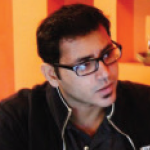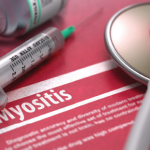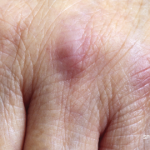The Presentation

lzf / SHUTTERSTOCK.COM
A pale, quiet woman—her mother—wheeled the girl into my clinic. It was a blistering Florida day, and the girl was shivering. She glanced up at me when I said hello and asked her name.
“Hi,” she said, giving me a broad smile. Her smile was the only broad thing about her. Her elbows and knees had contractured, twisting her into a narrow curlicue of herself. “Thank you for seeing me.”
“You’re very welcome. Tell me what brings you here.”
“Two years ago, I used to run 5Ks,” she said, “and now I can’t. Now,” she said, looking me in the eyes, “I’m here.”
I looked back at her, tried a smile, turned to the computer screen and typed.
We’re in Gainesville at the University of Florida. It’s a nice place. I like being here. I like that, after a hiatus of six years working as a hospitalist in a relatively under-resourced location two hours away, referring complex patients to a higher level of help, now I am that higher level of help. I’m training to be a subspecialist, a rheumatologist—or so I hope.
This is where the patients I used to refer—helpless, dread-filled people, benighted by their disease—come. This young woman here is one of them, and now I am the one filled with dread.
History
Her local rheumatologist sent her to us. She is 23 years old.
We went over her disease course. Two years ago, she could run miles, and now she can’t. A mysterious weakness had raged through her, weakening her muscles, inflaming her joints, enervating her until she was bedbound. She has had multiple hospitalizations in different community hospitals, interminable wait times for test results—for an answer—biopsies of her liver, muscles, skin, and the calcium deposits that had erupted everywhere. One year ago, she had responded to plasma exchange a neurologist ordered for her when she was hospitalized. She walked for a week before her strength rapidly waned.
She used to waitress, humming songs to herself, as she paid her way through college, and now she can’t. One neurologist. Two rheumatologists. Two dermatologists. More waiting. More tests, more flares, more unknowns. Unfamiliar terms, such as autoimmune disease, ALS, seronegative lupus, chronic Lyme disease, scleroderma and overlap syndrome had been incessantly thrown at her.
Back to the Present
So now she was here in my Fellows Continuity Clinic. Debilitated, twisted and in pain, and she wanted hope or death. In her eyes I saw both. The ravages of mind and body she had undergone had marked her permanently, and I was afraid. But I thought I knew what she had.
I pulled up her bloodwork, and the few images she had brought with her.
“I don’t have enough data yet,” I said, placing a hand on hers. “But judging by your history and exam,”—she stared at me—“the rash around your eyes, posterior neck, left arm, the back of your hands and feet; the way your muscles have weakened and wasted so quickly; and these hard lesions,” I pointed at the ridges of calcinosis around her joints, on her jaw, arms and pressure points, “I think you have a form of dermatomyositis.”
Her mother gripped her wheelchair. They were so quiet. I wondered for a moment if she had been a loud teenager, if she loved blasting songs from her car, maybe sang madly sometimes when she ran like the wind on a cool morning. I didn’t ask her.
Discussion
Dermatomyositis is a sinister autoimmune disease. A subset of inflammatory myopathies, the disease manifests with a spectrum of rashes most pronounced on the back of the hands, around the neck, eyes and shoulders, as well as significant muscle weakness, ranging from amyopathy to severe polymyopathy. It can start with either skin or muscle involvement and can be difficult to diagnose, especially because some of the antigen-specific antibodies that drive the inflammatory response weren’t even discovered until this past decade. More and more such antibodies are being discovered yearly, so the standard tests many community physicians rely on can produce misleading results.
A particular subset of dermatomyositis, once called dermatomyositis sine myositis and now known as clinically amyopathic dermatomyositis (CADM), can be particularly tricky to diagnose, because many patients may not have any muscle involvement at the onset of disease. The antibody most often associated with this subset, the anti-MDA5 or anti-CADM 140, is not part of the standard myositis panel and must be specifically ordered. This antibody-specific myositis can exhibit rapidly progressive interstitial lung disease, severe erosive arthritis and mechanic’s hands—cracking and thickening of the skin in the eponymous organ.
My young patient would eventually turn out to have this particular antibody.
We talked some more. I brought my attending in. We examined her together. We believed we had the correct diagnosis.
Did she look relieved? I suspect we might have given her some hope. Her eyes were brighter. When, gentle as we could, we told her we would—perhaps—not be able to restore her to prior function and that much of the damage to her joints was likely irreversible, tears slipped down her cheeks. Her chest hitched only once. I don’t know if she knew she was crying.
“But we have hope,” we said, “and several treatment options, once we’ve confirmed what you have. We’re hopeful that we can halt the disease process and get you a degree of function back, but we do need some time and more tests.”
More tests. I hated saying that. It’s perhaps the truest statement we have, but who hasn’t hated the truth at least once?
She brushed a strand away from an irregularly receded hairline. “Will I be able to walk again?”
“I don’t know,” I said. “I hope you might be able to with treatment and significant rehab, but you have significant joint damage from calcium deposits and severe inflammation in your joints. It will be a long road.”
She knew that. She wasn’t stupid. She was a straight A student in high school. She tried to smile at us. “I can do the rehab.”
We discussed treatment options and, bloodwork pending, settled on a tentative one: continuation of low-dose steroids and addition of intravenous immunoglobulins while we sent safety labs for potential use of cyclophosphamide infusions. I signed orders, scheduled a return appointment and escorted her out. I watched her get wheeled away, while she was sitting up as straight as she could muster.
‘Judging by your history & exam, … the rash around your eyes, posterior neck, left arm, the back of your hands & feet; the way your muscles have weakened & wasted so quickly; & these hard lesions,’ I pointed at the ridges of calcinosis around her joints, on her jaw, arms & pressure points, ‘I think you have a form of dermatomyositis.’
Follow-through
As a hospitalist, I disliked not being able to see my patients all the way through treatment and outcome. Even when I made a useful diagnosis, I couldn’t follow my patients past the hospital doors. They went on to their primary care providers, cardiologists, pulmonologists, rheumatologists. Hospital medicine is essential to modern healthcare. It is also quintessentially halfway medicine, incomplete for many of its practitioners. Go to any community (or academic) hospital, and you’ll see how quickly it can become algorithmic. Requesting a consult can become a reflex. Order sets (standardized admission orders) become the quick template you use more and more to make it home for dinner. The excitement of learning and discovering fizzles out, leaving you an empty husk of who you once thought you wanted to be. Sometimes, I suspect the subsequent anhedonia, more than job stress, is the reason so many hospitalists can burn out. I know I did.
When you’re on the consulting end, though, you are the last resort—or should be. A subspecialist has massive trust placed on their assessment and conclusions. My experience, as a trainee subspecialist, is that trust and responsibility are often amplified. Will you push your efforts, your gut feelings, your knowledge (or lack thereof) of a particular disease to the brink so as not to fail a complicated patient? You don’t have to be the best physician in the world, but you can be a decent human being, wanting to help sick and frightened people the best you can, and decency demands a degree of kindness and responsibility.
I hoped my patient’s extended myositis panel would reveal the antibody specific to her particular inflammatory myopathy (and it eventually did). I hoped we could then move on to an organized treatment plan, help her as best as we could. Yet I couldn’t shake the fear of failing her.
My patient isn’t the only one who likes running. I went home and ran a bit that night, thinking of her. Encaged by the fossilization of her flesh, she likely still dreams. She has plenty of time to think. She probably underlines sentences in the books she reads. She is unfailingly polite to me, but is she always polite to those around her? Infirmity can bring anger and bitterness. What is she like? What was she like? Who did she used to be? How cramped and tight and painful those shoes I was trying to put on briefly.
I hope she walks again, that one day, she gets out of that wheelchair and walks two steps, then a few more. A gunmetal sky above her, she doesn’t care. She plugs those headphones in, zips up her jacket and gently increases her pace. The road stretches before her, stark and quiet and beautiful. She smiles and stretches her arms out to the wind. Tentatively, she begins to run.
And running, she begins to sing.
 Usman T. Malik, MBBS, is a second-year rheumatology fellow, training at the University of Florida in Gainesville. In his spare time, he runs distance and writes tolerable speculative fiction.
Usman T. Malik, MBBS, is a second-year rheumatology fellow, training at the University of Florida in Gainesville. In his spare time, he runs distance and writes tolerable speculative fiction.



